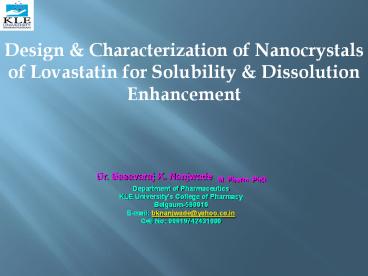Design - PowerPoint PPT Presentation
1 / 19
Title:
Design
Description:
Design & Characterization of Nanocrystals of Lovastatin for Solubility & Dissolution Enhancement Dr. Basavaraj K. Nanjwade M. Pharm, PhD. Department of Pharmaceutics – PowerPoint PPT presentation
Number of Views:111
Avg rating:3.0/5.0
Title: Design
1
- Design Characterization of Nanocrystals of
Lovastatin for Solubility Dissolution
Enhancement
Dr. Basavaraj K. Nanjwade M. Pharm,
PhD. Department of Pharmaceutics KLE Universitys
College of Pharmacy Belgaum-590010 E-mail
bknanjwade_at_yahoo.co.in Cell No 00919742431000
2
Introduction
- Nanocrystal
- Definition
- Drug nanocrystals are nanoparticles being
composed of 100 drug without any matrix
material. - Methods of production
- - Bottom up technology
- Precipitation
- - Top down technology
- High pressure homogenization
3
- Objectives of the study
- To increase the drug solubility dissolution.
- To increase the drug bioavailability.
- Materials Methods
- Materials
- Drug Lovastatin (Krebs biochemicals Pvt. Ltd.,
Hyderabad) - Solvents Acetone, Methanol, Acetonitrile
4
- Method
- All the formulations were prepared by
Precipitation method. - Involves two steps..
- Preparation of drug solution in solvent
- Addition of drug solution to water
5
Nanocrystal preparation
Sr. no. Code Organic solvent LVS Concentration in solvent (mM) Dilution of LVS solution to water Dilution of LVS solution to water
Sr. no. Code Organic solvent LVS Concentration in solvent (mM) Volume of LVS solution (ml) Volume of water (ml)
1. 2. 3. 4. 5. 6. F1A F1B Acetone 3 mM 4 mM 12.3 ml 10.8 ml 615 ml 540 ml
1. 2. 3. 4. 5. 6. F2A F2B Methanol 3 mM 4 mM 12.3 ml 10.8 ml 615 ml 540 ml
1. 2. 3. 4. 5. 6. F3A F3B Acetonitrile 3 mM 4 mM 12.3 ml 10.8 ml 615 ml 540 ml
6
Evaluation parameters
- a) Particle morphology
- b) Particle size analysis
- c) Crystalline state evaluation
- - Powder X-ray diffraction (PXRD)
- - Differential scanning calorimetry
(DSC) - d) Solubility determination
- e) In vitro release study
- f) In vivo evaluation
- g) Stability study
7
Result discussion a) Particle Morphology
F1A
Pure LVS
F2A
8
b) Particle size analysis
9
c) Crystalline state evaluation
Powder X-Ray diffraction (PXRD)
A
A
A
10
- Differential scanning calorimetry (DSC)
A
Endothermic peak 174.57C
A
Endothermic peak 174.87C
A
Endothermic peak 173.92C
Endothermic peak 175.19C
11
d) Solubility determination
Sr. No Media used Solubility in each media (mg/ml) Average SD Solubility in each media (mg/ml) Average SD Solubility in each media (mg/ml) Average SD Solubility in each media (mg/ml) Average SD Solubility in each media (mg/ml) Average SD Solubility in each media (mg/ml) Average SD Solubility in each media (mg/ml) Average SD
Sr. No Media used Pure LVS F1A F1B F2A F2B F3A F3B
1. Distilled water 0.005 0.01 0.092 0.02 0.089 0.03 0.090 0.05 0.084 0.02 0.081 0.01 0.076 0.02
2. Acidic buffer PH 1.2 0.007 0.03 0.148 0.04 0.136 0.02 0.131 0.03 0.129 0.04 0.097 0.03 0.089 0.04
3. Phosphate buffer PH 7.4 0.008 0.02 0.176 0.01 0.161 0.04 0.173 0.01 0.154 0.03 0.134 0.04 0.105 0.01
12
e) In- vitro release studies
13
- f) In- vivo evaluation
- In vivo drug release of pure LVS
In vivo drug release of F1A and F2A nanocrystals
14
- Comparison of Bioavailability of LVS nanocrystals
Code Absolute bioavailability Relative bioavailability Area under curve(0-8) (µg/ml.hrs) Cmax (µg/ml) Tmax (hrs.)
Oral control group - - - - - - - - 802.8 5.849 0.245 2
IV control group - - - - - - - - 986.7 9.546 0.094 5
F1A 0.826 1.015 815.3 6.325 0.324 2
F2A 0.821 1.010 810.9 5.590 0.432 2
Time in minute Values of Cmax are mean
standard deviation
15
g) Stability study
- Drug content after 30 days storage of F1A
Code Percent drug content at 40C Percent drug content at 300C20C / 65 5 RH Percent drug content at 400C20C/ 65 5 RH
F1A 66.46 66.32 60.54
16
-
Continued..
- Release study of F1A stored at 40C, at 300C20C
/ 65 5 RH and - at 400C20C/ 65 5 RH
Time (Min.) Cumulative LVS release stored at 40C Cumulative LVS release stored at 300C20C / 65 5 RH Cumulative LVS release stored at 400C20C/ 65 5 RH
15 44.96 45.23 41.03
30 59.16 59.63 54.24
45 70.20 70.86 65.03
60 75.03 75.53 71.26
90 82.97 83.18 79.06
120 87.06 87.45 82.36
150 90.31 90.35 88.65
180 93.76 93.06 89.30
17
Conclusion
- From the particle morphology by SEM, it was
observed that LVS nanocrystals remain
crystalline. - Less particle size was observed in case of F1A
F2A as compared to all other. - From PXRD and DSC data, it was observed that F1A
, F2A F3A showed no significant change in
crystalline as compared to pure LVS. - Solubility was enhanced due to less particle size
solvent used (acetone methanol).
18
Conclusion
- In-vitro release rate studies showed that the
maximum drug release was found in the F1A F2A
in the required period of time. - In-vivo relative bioavailability of F1A F2A was
slightly increased as compared to absolute
bioavailability. - From stability study data it was revealed that
nanocrystals of lovastatin remained more stable
at 4ºC. The maximum instability of nanocrystals
was observed at 40?2?C.
19
THANK YOU
- THANK YOU.
E-mail bknanjwade_at_yahoo.co.in Cell No
0091974243100































